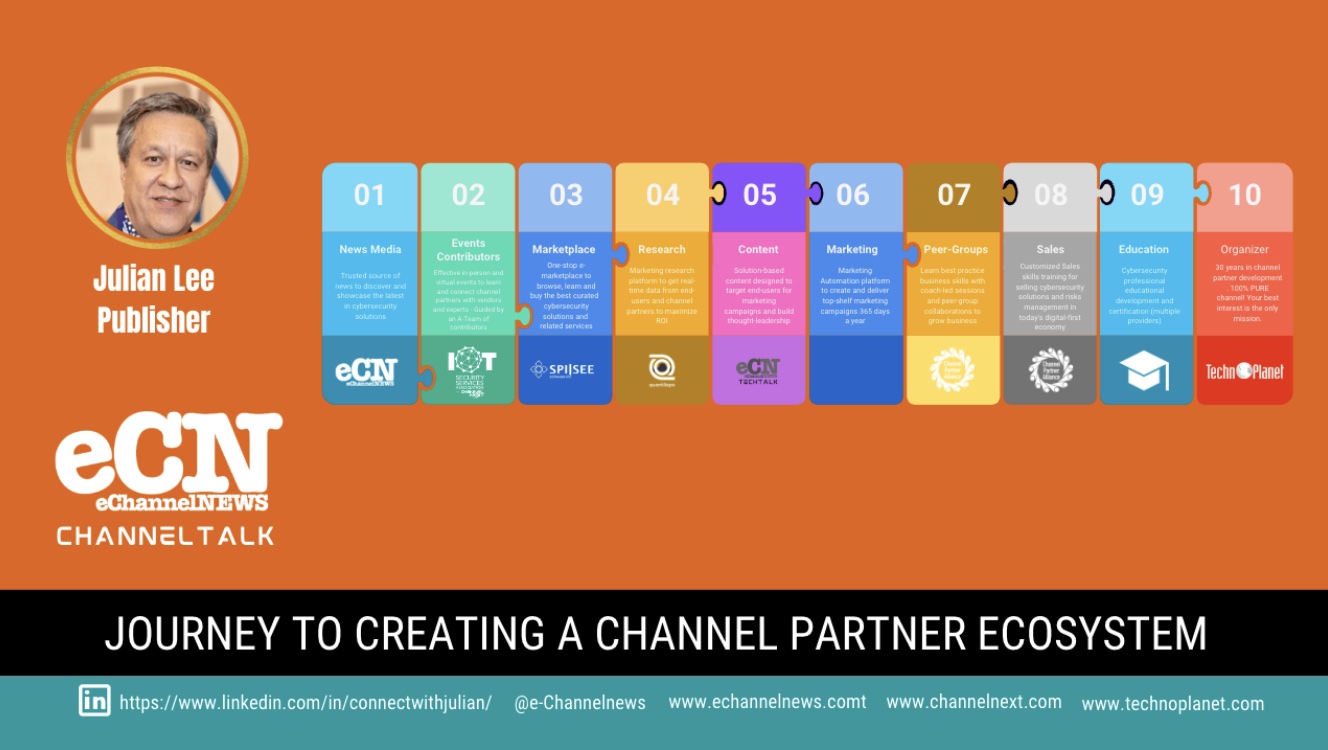Today, there are two primary partner types that dominate the ecosystem that has been evolving over the past 40 years: Transactional and non-transactional. This evolution has been mostly fuelled by changes in the buyer’s behaviours and how products are consumed (which has now accelerated due to the pandemic).
On a macro-level, the new partner ecosystem is composed of many diverse players. How the DNA of these different organisations continue to interact and adapt is still evolving.
However, we already know quite a few things that will mould its future.
One of the biggest steering factors is the acceleration of so many companies building Intellectual Property (IP) in the channel. Many years ago, we were talking about how the future channel partner winners will be those who are able to create IP and become more like a vendor. That’s now a common thing.
As more companies continue to develop apps (and IP) that integrate with all sorts of third-party platforms and applications, the number of connecting points between vendors and line of business opportunities are expanding far beyond any stand-alone vendor partner ecosystem.
The once closed vendor-centric partner environment is now morphing into an open ecosystem.
Transactional And Non-Transactional Models
Transactional partners in the ecosystem facilitate the actual sale of products between the vendors and the resellers who simply add a margin or service before reselling to end users. Today, most partners bake-in some mix of managed services. This type of transactional playbook will continue well into the future.
In addition, there are consultants who typically recommend solutions to end-users. Sometimes, they work with channel partners to fulfill the order. Other times they receive a referral fee. Other times still, they leave it to end-users to procure the hardware but charge for implementation and maintenance.
Today, we categorize these people as non-transactional “influencers”. In addition, news media, vendor rating systems, partner community networks and other channel experts are all significant influencers in today’s channel ecosystem. Collectively, this group can dramatically impact the sales growth of vendors. Finding ways to collaborate with a variety of non-transactional partners can be a powerful competitive advantage.
Partner Collaborations
Partner-to-partner collaborations have been quite common for many years and are still going strong. When a partner can’t do a job because of lack of expertise or they are too far to service the client, they reach out to other partners to help and share in the revenue. Some partners have told me that revenues generated from collaborating with other partners account for about 25% of their total business. This P2P model has been gaining significant growth as partners look to outsource/partner with specialized Cyber Security MSSPs and SOCs. It’s going to vary dramatically by partner but it’s fair to say the P2P revenue will continue to be significant. Vendors may want to explore how they can inject themselves to influence these P2P relationships and partners may want to expand their own P2P ecosystem to grow.
MSP business automation platforms are also building ecosystems and marketplaces (e.g. Datto and Connectwise). Some of these tools allow other third-party vendors to plug in to sell. In most cases there are no transactional fees for vendors to tap into these specialized ecosystems.
At the same time, we continue to see the expansion of Telcos within the IT channel. As they buy more MSPs they will continue to carve out a bigger piece in the channel. Just recently, a large Telco (Telus) acquired a large MSP (Fully Managed). The big Telcos superpower is its control over the broadband access that every business needs. As next level wireless networks like 5G take root, their influence will most likely increase.
[On a side note, MSPs and other traditional channel partners may want to get into the 5G game sooner rather than later as this may be a smart path to defending their position from Telcos. To learn more, you can check out a 60-minute video discussion on the topic that I recently had with the 5G experts from Cradlepoint]
Today, we already have digital marketing agencies, accounting firms and digital business transformation consultants looking to carve out a piece of the channel pie. They bring yet another dynamic to the selling of technology within the ecosystem. Many of these companies already have significant wallet-share, mindshare and trustworthiness with their customers so both vendors and channel partners may want to explore go-to-market relationships with this group.
This is all happening on a backdrop of about 200,000 SaaS companies currently flooding into the ecosystem. This has since fueled the growth of several Cloud/SaaS distributors and the building of specialized partner ecosystems. We are already seeing the impact that they are bringing to the channel landscape.
The channel ecosystem is also getting more integrated with marketplaces. The big players already know that controlling the entire ecosystem is smart business. Apple (the first marketplace kingpin) currently exerts extensive control over all of their channel partners, vendors and influencers. Try repairing Apple equipment without their authorization. Try being a vendor in their app marketplace to understand the rules of engagement. It’s quite extraordinary.
Others are gunning for their piece of the marketplace pie as they all move towards more control of their channel ecosystem. I really do not know how many marketplaces will dominate the globe (I have heard about 20 from channel analyst Jay McBain of Forrester), but it seems like Apple, Microsoft, Amazon and Google will get the lions’ share. That said, as these marketplaces blow up to become mega entities, you will see many niche marketplaces spinning off (current examples include Ingram Micro, Sherweb, Pax8 and App Direct (purchased ITCloud)).
For every type of player in the ecosystem, vendors will need a corresponding strategy to leverage and generate revenue. If not, they may lose a competitive advantage. Vendors may want to get on their good side by finding clever ways to engage with them through personalised programs, tactics and incentives.
Where are we at?
- The channel ecosystem is getting very complicated.
- A different type of big-picture leadership and thinking is going to be needed.
- It will require proper orchestration as well as new measurement metrics.
- The rules of engagement will be very different from the traditional buy-sell partners.
The current channel playbooks and management are simply not yet up to speed in dealing with such a diverse community. How do you compensate someone who just recommends your product but is not interested in buying or selling it? What if they do not even want to be promoted by you? How do you work with someone who just uses your application to solve one specific need within their solution (without you knowing)?
With the “zillions” of plug-ins that currently feed platforms like WordPress, Shopify etc. These “sell-with” relationships are not ingrained in the playbooks of traditional channel teams.
Microsoft seems to be jumping ahead with their revised partner playbook in 2022. Their partners will soon be “rated” with a new scoring system (New Commerce Experience) that will somehow be tied to several attributes like certifications, solutions, markets and successes instead of the traditional tiered approach based on pure sales volume. Rewards and support will be based on the partner’s “net score”. In theory, this sounds like a good thing that could provide a more equal opportunity playing field to a diverse set of partners, but I am not sure if actual sales volume will ever take a back seat. Too often, partners with the biggest sales volume have found a way to game the system.
Vendors will need to figure out how to partner with and reward a diverse set of partners in their ecosystem. We are currently in the midst of developing new playbooks for several vendors, but it’s not easy. Much has to be built from scratch. It will require different thinking as well as a new set of partner automation tools (we are currently testing some to manage next-gen ecosystems).
It makes sense that all types of partners will need some sort of a “score” or rating system based on several factors of value that they bring to the table. Based on this score, the partner will receive a certain set of incentives, rewards and support. All partners who bring value to the ecosystem should receive appropriate rewards.
How important are non-transactional partners?
In one word, VERY. In a recent virtual event, a DropBox’s channel chief claimed that about 30% of their revenue will come from “influencers” in 2022. Intel is currently working on redefining their channel playbook to better integrate more types of partners into their ecosystem.
Still, others are sticking to the sales volume approach which makes sense especially for some hardware-type vendors (Eaton just celebrated their 10th year anniversary of their partner program with no plans to change anytime soon). That said, hardware-type vendors will also have non-transactional influencers that they should not overlook. As Hardware-as-a-Service becomes normal, the usual transactional barriers will eventually dissipate and open more opportunities for non-transactional partners.
It’s very important to understand how the sum of each type of partner will drive the overall synergy to accelerate business growth in the channel.
It may be wise to treat every player as the next potential MVP as you explore how they can impact your ecosystem. Retrain your channel team to become better business advisors instead of sales reps. Educate them to better help their partners develop plans and opportunities without the lens of how much they buy. The new channel job is to connect the dots to facilitate and motivate all types of partners to collaborate and contribute to the overall success of the ecosystem.
Everyone has to be a valued member in your ecosystem or they shouldn’t be there. If you are able to achieve a harmonious and diverse status, then you should see the members in your ecosystem find more ways to grow business that you never even considered.
[Side note: Watch out for partners being gobbled up in the mergers and acquisitions game. The “purchasing” partner will ultimately dictate the vendor lineup moving forward so if you are a vendor on the wrong side of the fence, then you can quickly lose a top partner]
Where do we need to go?
Vendors need to accelerate their learning and apply new thinking to rework their partner ecosystem. It will most likely require a new set of partner automation tools as trying to do what you need to do with a traditional partner relationship platform may be like trying to fit a square peg into a round hole.
Channel partners also need to start looking beyond their bubble and explore how these new entities can impact and help them to grow success. Start talking with the “newbies” entering the ecosystem and learn how they think and explore ways to work together. Start promoting and building on the value you bring to the partner ecosystem.
Finding the perfect “algorithm” to best motivate each player is the new mission of vendors looking to build an effective channel partner ecosystem in the future.
Stay tuned…this is just the beginning. Hit us up if you wish to dive deeper into building the next generation of channel partner ecosystems.




